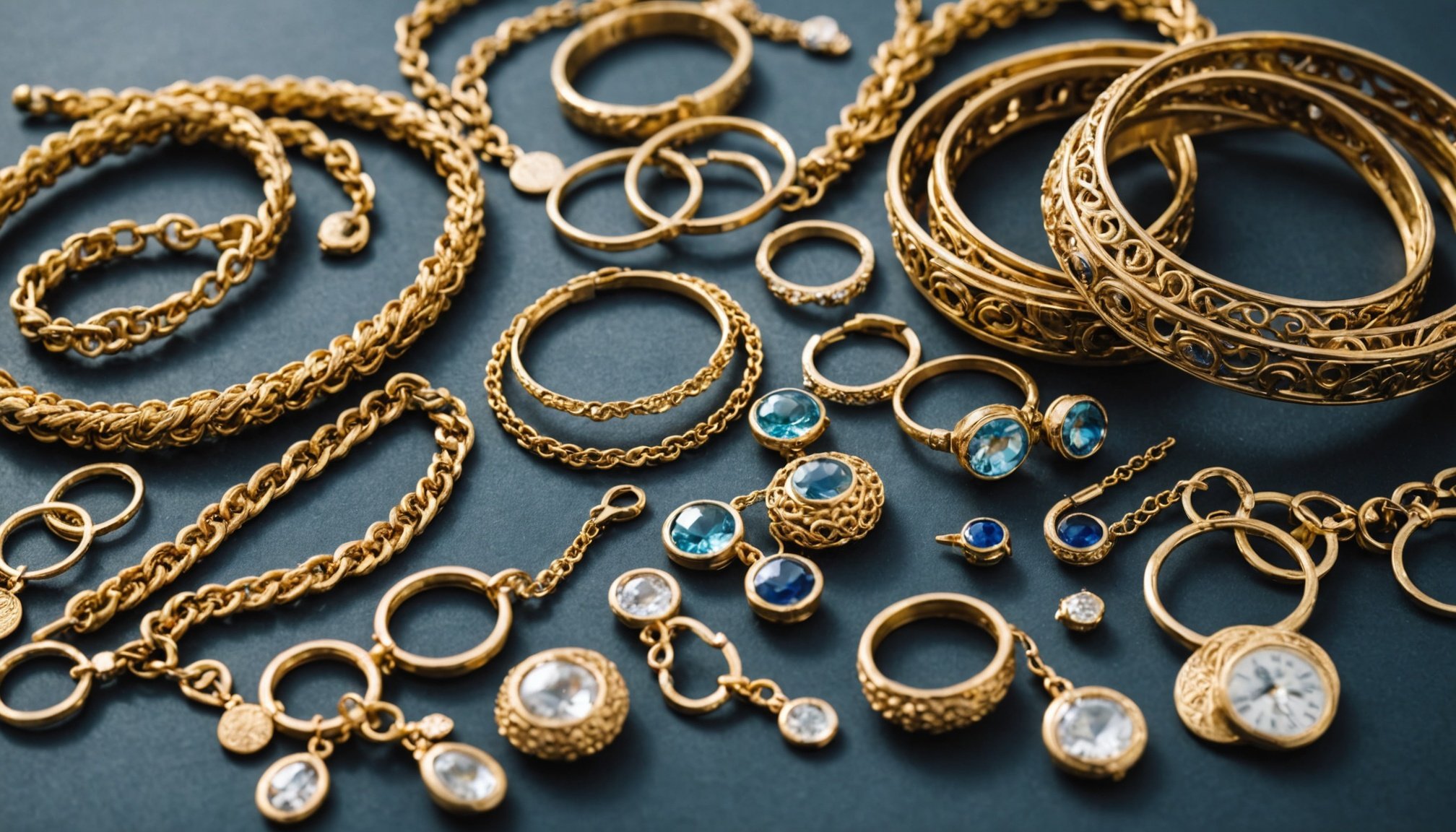Understanding Jewelry Tarnish in Humid Conditions
Jewelry tarnish is a common issue faced especially in humid weather. This undesirable effect is primarily due to moisture in the air, which accelerates chemical reactions on the jewelry surface. Understanding tarnish is crucial to maintaining the aesthetic appeal of your accessories.
Humidity leads to tarnish through chemical reactions involving sulfur compounds in the atmosphere. When these compounds come into contact with metals like silver, a tarnish forms, often seen as a black or green layer. Other jewelry materials, such as copper and brass, are also vulnerable, resulting in a dull appearance due to oxidation. However, gold is generally more resistant, but it can still lose its lustre if it contains alloyed metals that react with moisture.
Also to read : Chic and simple updo styles for medium-length hair: quick looks you”ll adore!
Moist environments enhance these reactions, causing tarnish to form more rapidly. Knowing about the materials in your jewelry can help you better predict how they will react to humid conditions. For instance, silver and copper are prone to tarnishing more than stainless steel or platinum. By comprehending the impact of humidity on various materials, you can adopt strategies to protect your cherished pieces from tarnishing in damp climates.
Regular Cleaning Techniques for Jewelry Maintenance
Maintaining the brilliance of your jewelry requires consistent cleaning practices. Using specific products is vital. Silver polishing cloths and non-abrasive liquids designed for jewelry maintenance are recommended for preventing tarnish. These products help remove surface impurities and delay the formation of tarnish, effectively preserving the shine and clarity of your accessories.
Also read : Your go-to handbook for choosing the ideal long-lasting liquid lipstick for busy days
Step-by-Step Cleaning Process
- Gather Supplies: Secure a polishing cloth, mild soap, and soft toothbrush.
- Create Cleaning Solution: Mix warm water with a few drops of soap.
- Soak Jewelry: Immerse for a few minutes, allowing dirt to loosen.
- Brush Gently: Use the toothbrush to scrub detailed areas.
- Rinse Thoroughly: Rinse under lukewarm water to ensure all soap is removed.
- Dry: Pat dry with a microfiber cloth to avoid scratching.
The frequency of cleaning varies based on use and environment. For jewelry worn regularly, a monthly clean suffices for upkeep. However, in areas with high humidity, consider biweekly cleaning to prevent accelerated tarnish. These methods not only maintain appearance but also extend the lifespan of your jewelry, safeguarding your investments effectively. Regular cleaning keeps tarnish at bay, ensuring continuous wearability and enjoyment.
Effective Storage Solutions for Jewelry
Protecting your jewelry from tarnish begins with strategic storage solutions. Investing in anti-tarnish pouches and cloths is a simple yet effective method. These products are designed to absorb moisture, creating a protective barrier between your jewelry and the surrounding air, thereby helping prevent tarnish. Additionally, storing your jewelry in a controlled environment is vital. A storage setting with stable temperature and low humidity will deter the chemical reactions that lead to tarnish.
Organising your collection thoughtfully can greatly minimize exposure to humidity. Consider compartmentalised jewelry boxes, which allow you to separate items and reduce their contact with air. Options with airtight seals or dehumidifiers incorporated can be especially helpful in humid climates.
- Anti-tarnish pouches: Absorb sulphur and moisture.
- Airtight containers: Limit air exposure.
- Compartmentalised storage: Prevents metal contact.
Using these preventative measures not only maintains the aesthetic integrity of your prized pieces but also extends their lifespan. By adopting these storage solutions, you protect your jewelry collection, leading to less frequent cleaning and upkeep in the long run. Stay proactive to ensure your treasures retain their brilliance, accentuating your unique style effortlessly.
Choosing the Right Materials for Humid Climates
Selecting tarnish-resistant jewelry materials is crucial in humid climates. Materials that resist tarnishing ensure durability and maintain their aesthetic appeal even in moisture-rich environments. In humid conditions, metals like gold and platinum stand out due to their natural resistance to tarnish. Pure gold, especially, is less reactive with elements in the air, making it a reliable choice for everyday wear in humid areas.
When considering alternative options, stainless steel is a commendable choice. Its robustness and ability to withstand tarnish make it excellent for high humidity. Similarly, titanium and tungsten carbide exhibit strong resistance to corrosion and maintain their sheen over time.
For those interested in gemstones, synthetic gems like cubic zirconia often fare better than porous stones such as opals or pearls, which require extra care due to their sensitivity to moisture.
Ultimately, by opting for tarnish-resistant materials, you reduce maintenance efforts while ensuring your jewelry remains sparkling and delightful. This proactive approach not only safeguards your collection from the damaging effects of humid weather but also prolongs the lifespan of each piece, making it an investment worth cherishing.
Products and Tools for Preventing Tarnish
Understanding the significance of tarnish prevention products can greatly assist in preserving the allure of your jewelry. Some innovative gizmos like humidity absorbers and dehumidifiers play a pivotal role in keeping moisture at bay, vital in thwarting tarnish.
Humidity absorbers effectively reduce atmospheric moisture, shielding your prized pieces. Consider placing these compact products in your jewelry box and alongside your other accessories. Dehumidifiers, whether portable or installed within a room, create an optimal environment by maintaining low humidity levels. This investment can substantially lengthen the lifespan of your jewelry collection.
Various at-home solutions and DIY methods are available for budget-conscious individuals. For instance, crafting an anti-tarnish solution using common ingredients like vinegar, baking soda, and water can act as an efficient cleaning and prevention method.
- DIY anti-tarnish mix: Mix vinegar and baking soda to cleanse and protect.
- Humidity absorbers: Position them among stored items.
- Dehumidifiers: Use in storage areas for long-term protection.
These strategies, along with specified products, form a comprehensive shield against tarnish, ensuring your jewelry remains brilliant and delightful regardless of the surrounding humidity levels.
Expert and User Insights on Jewelry Care
Jewelry lovers often search for invaluable jewelry care tips to protect their cherished pieces. Insights from both expert advice and personal experiences provide a well-rounded perspective on effective tarnish prevention. Jewelers with years of industry know-how recommend a proactive approach: selecting jewelry materials suited to individual climates and employing anti-tarnish tools. Their professional advice often emphasizes routine maintenance and awareness of material qualities for longevity.
User testimonials shed light on practical experiences. Many share successful strategies like using prevention products and consistent cleaning schedules. These firsthand accounts stress the benefits of using humidity absorbers and dehumidifiers, revealing their effectiveness in varying climatic conditions.
Community forums and blogs add another layer of knowledge. These platforms are rich with user-shared jewelry care tips, highlighting diverse approaches from DIY solutions to product recommendations. Here, individuals swap trial-and-error stories, offering advice grounded in personal triumphs and challenges.
By paying attention to both authoritative and lived experiences, a clearer picture of effective jewelry care emerges. This dual insight enhances decision-making, ensuring pieces remain stunning amid the challenges of climate and wear.
Monitoring Humidity Levels in the UK
Being aware of humidity levels is crucial for effective jewelry care, especially in the diverse UK climate. Different regions across the UK experience varying levels of humidity, with coastal areas often more prone to higher moisture. Typical humidity levels range from 70% to 90%, which significantly impacts how certain jewelry materials react over time.
Monitoring these levels is essential. Several tools are available to help track and respond to changes in home humidity. Hygrometers are a reliable option for measuring air moisture, providing an accurate snapshot of your environment. Apps and smart home systems can offer additional convenience, allowing for real-time updates and alerts on humidity changes.
Seasonal variations also influence jewelry care strategies. For instance, spring and autumn often bring increased humidity, making it a prime time to reinforce protective measures for your accessories. During these seasons, ensuring your jewelry remains in a controlled environment can minimise tarnishing effects.
Remember, proactive awareness and adjustments based on humidity changes can greatly benefit the longevity and brilliance of your jewelry, aligning care routines with the unpredictable UK climate.











